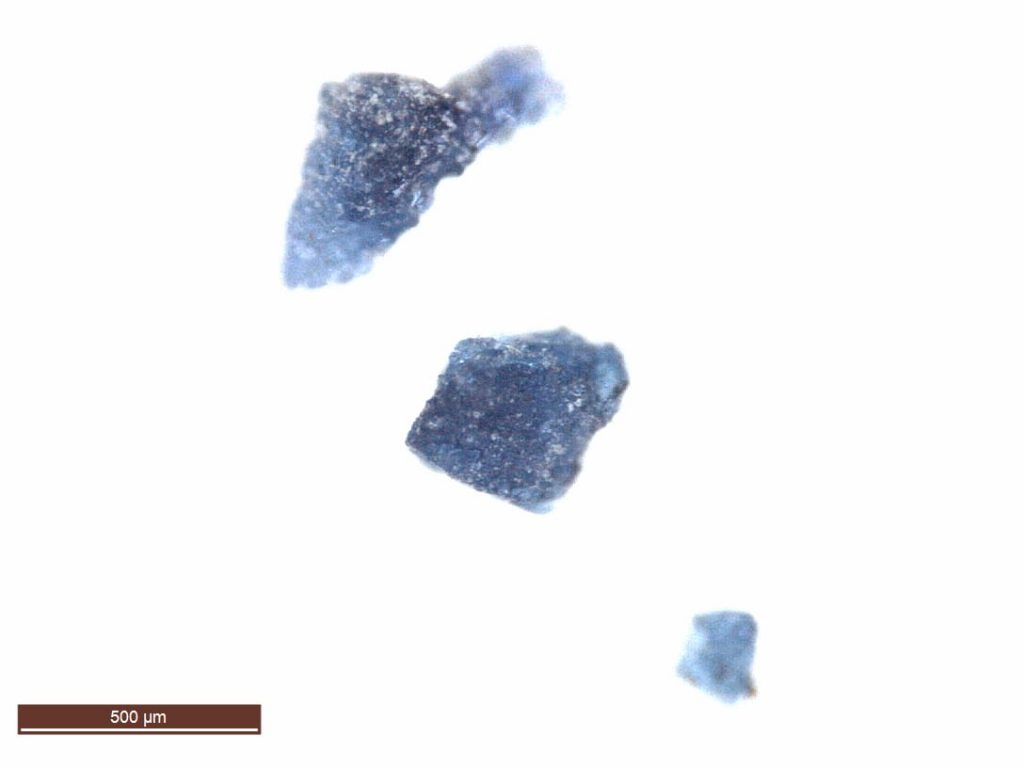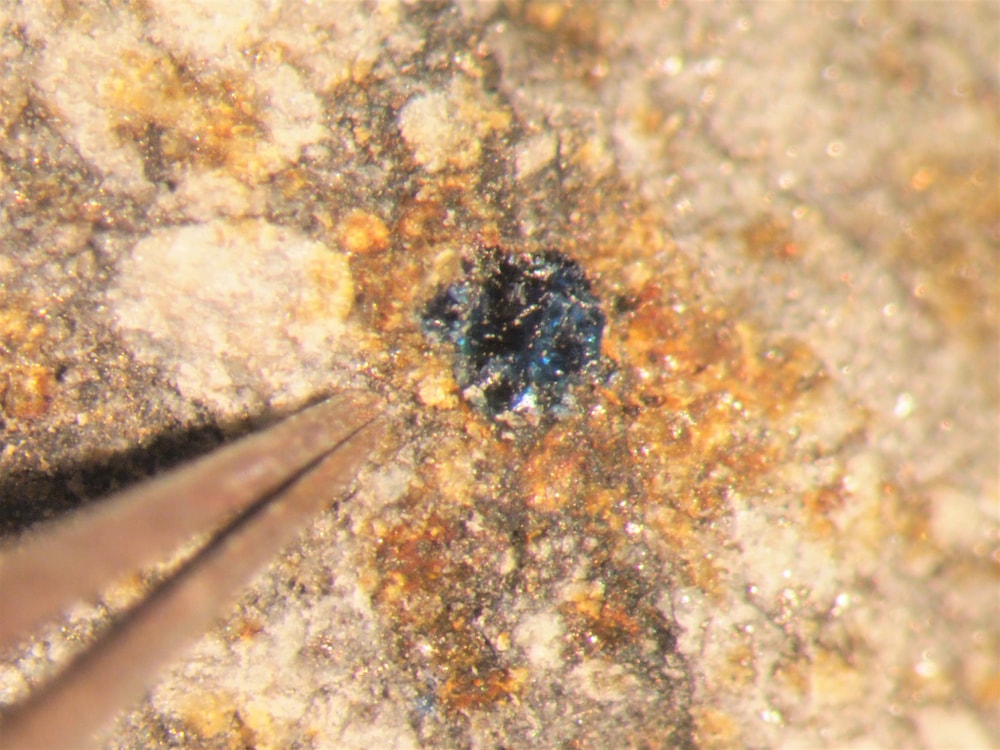An Ingredient For Life In Our Solar System: Salt
7:50 minutes

When meteorites fall to Earth they bring with them a taste of what’s out there in our solar system. For example, two meteorites that landed in 1998, Monahans and Zag, were quite…salty. Each meteorite contained blue salt crystals that the asteroid had picked up along its violent trajectory towards Earth. Now, two decades later, scientists are able to determine where they might have come from and what events most likely brought them here. Queenie Chan, post-doctoral researcher at the Open University in Milton Keynes, United Kingdom, joins Ira to discuss what the discovery tells us about the building blocks of our solar system.
[Researchers are working on a temporary relief for tinnitus sufferers.]

Queenie Chan is a post-doctoral researcher at The Open University in Milton Keynes, United Kingdom.
IRA FLATOW: This is Science Friday. I’m Ira Flatow.
You know, when meteorites fall to Earth, they bring with them a taste of what’s out there in our solar system. And for two meteorites, the Monahans and Zag that crash landed here in 1998, that taste was quite salty. Each meteorite contained blue salt crystals that the asteroids picked up on their violent trajectories toward Earth. And now two decades later, scientists have taken a closer look at those crystals and discovered organic compounds that make up the building blocks of life.
Let me bring on my guest to talk about it, Dr. Queenie Chan, former researcher at NASA’s Johnson Space Center in Houston, now with the Open University in the UK. Dr. Chan, welcome to Science Friday.
QUEENIE CHAN: Hello, five to eight hours apart across Atlantic from the UK. Thank you for having me here, Ira. I’m very excited.
IRA FLATOW: Very happy to have you. Please, tell us. What’s the story with these two meteorites with these funny names? Where and when did scientists find them? Where did they come from?
QUEENIE CHAN: Yeah, so these two meteorites, they both fell in the year, in 1998, 20 years ago already. They got their name from the town where they fell, so the first one being the Monahans. It fell in a town called Monahans in Texas. It was fell next to a basketball court, actually, with kids playing around. So it was some kids who found it. So they were about maybe 13 years old, or 10 years old. So 20 years after, nowadays, they may be of my age now. So the other meteorite is Zag, which fell in Morocco, also in the same year.
And we’re lucky that both meteorites fell at a really dry environment. So it was kind of protected from terrestrial contamination and got retrieved really quickly and kept at the Johnson Space Center in a nitrogen cabinet to avoid all this contamination. So very exciting meteorites.
IRA FLATOW: So why did you have to wait 20 years before you could do more research on them?
QUEENIE CHAN: Yeah, so funny thing because 20 years ago, there were instruments that were available. The gas chromatography, mass spectrometry was available at that time to study organic compounds inside of meteorites. But we are looking at the salt crystals within the meteorite.
So the salt crystals are very small. Each of them are maybe about two millimeters in size. So in order to study the amino acids or organic compounds just within the salt crystal is really challenging. So just a few years ago, a technology called the high performance liquid chromatography has become available to us. And nowadays–
We used to have to use about 100 milligrams of sample, of meteorite sample, for our sample for GCMS, gas chromatography analysis, to look at the amino acid content. Of course, it depends on how much amino acids you’ve got in the sample. But usually, typically, about 100 milligram. And for the salt crystals, the blue, stunning salt crystals that we got, was about three milligrams.
IRA FLATOW: That’s a lot less.
QUEENIE CHAN: So it’s not even an nth of it. Yeah, and we need the technology, the sensitivity for studying the amino acid content.
IRA FLATOW: So did you learn anything new from these salt crystals?
QUEENIE CHAN: Yeah, so other than the meteorites both fell in the same year, got retrieved very quickly from a dry environment, they share something else in common. So first of all, these two meteorites were found to be heated from 600 to 550 degrees Celsius, which is about 1,700 degrees Fahrenheit, very high temperature.
But at the same time, they host blue salt crystals that were found to contain liquid water. So this liquid water, this water was found in a liquid form. When we open it, look at it under the microscope, we can see the liquid floating inside of the blue salt crystal. We saw a little bubble. And we moved the sample around, we saw a bubble moving here and there. So we know there is some sort of liquid inside of the salt crystal. So this is something already quite phenomenal.
IRA FLATOW: But wait a minute. Wait. Wait. Wait. Wait a minute. You found liquid water inside the salt crystal of a meteorite that’s been in that meteorite for how long?
QUEENIE CHAN: It’s almost as old as the meteorite. It was 4.5 billion years old.
IRA FLATOW: So it’s been traveling around the cosmos for 4.5 billion years with a little bubble of water in it.
QUEENIE CHAN: Yeah. Yeah, exactly. And it was found–
IRA FLATOW: Mind blown today.
[LAUGHTER]
QUEENIE CHAN: I was not the first person to find the liquid water. It was my adviser, also a co-author of this paper, found the liquid water for the first time. So it was astonishing the first time when we found it.
And then we wondered, OK, so we found liquid water. What comes with it? Is there any organic compounds? So that’s why we looked at the organic composition of these salt crystals containing the liquid water inside of them.
IRA FLATOW: And it came from where? I understand Ceres. Is that what you think it came from?
QUEENIE CHAN: That’s where we think the salt crystals are from. But it is interesting because when we are talking about the meteorite, as I was saying, it was heated up to 1,700 degrees Fahrenheit. Right? So at that temperature, water would have gone, would have left the salt crystal. So the fact that we’re still seeing salt crystal with the water in our lab, meaning that the salt crystal could be coming from another asteroid different from Zag and Monahans asteroid themselves.
IRA FLATOW: So it picked up a hitchhiker? The water is a hitchhiker from another asteroid?
QUEENIE CHAN: The salt crystal is a hitchhiker. That’s right. Yeah, probably Ceres or any other object or asteroid really rich in water, maybe having a water-like ocean, really organic-rich kind of asteroid.
IRA FLATOW: Wow. So this is not very common, I’m getting the drift here.
QUEENIE CHAN: [LAUGHS] No, not common at all that we find liquid water plus organic molecules in the same pocket.
IRA FLATOW: Wow. Where can we see it? Is it on exhibit anywhere? Are you just studying it?
QUEENIE CHAN: So we had– so what we did to extract the amino acids, or organic compounds, out of it, we had– for example, the Zag meteorite, the sample size is about 15 centimeters across. So it is a pretty big piece of meteorite. But in order to take the little tiny salt crystal out, the blue salt crystal out, I had to break the meteorite open little by little. So the entire 15-centimeter meteorite was broke open into something about half a centimeter size.
So at that time, it’s a mystery box. We don’t know what you would get. We don’t know what you’re getting. It’s like a quite fancy mystery box nowadays. Isn’t it? You buy it.
IRA FLATOW: You buy it. You don’t know what’s in it.
QUEENIE CHAN: You don’t what it is.
IRA FLATOW: All right, Dr. Chen. I’ve got to go. This is fascinating. And congratulations to you and your team.
QUEENIE CHAN: I’m glad to hear. Thank you.
IRA FLATOW: Dr. Queenie Chan, former researcher at NASA’s Johnson Space Center in Houston, now with the Open University in the UK.
Copyright © 2017 Science Friday Initiative. All rights reserved. Science Friday transcripts are produced on a tight deadline by 3Play Media. Fidelity to the original aired/published audio or video file might vary, and text might be updated or amended in the future. For the authoritative record of Science Friday’s programming, please visit the original aired/published recording. For terms of use and more information, visit our policies pages at http://www.sciencefriday.com/about/policies/
Katie Feather is a former SciFri producer and the proud mother of two cats, Charleigh and Sadie.